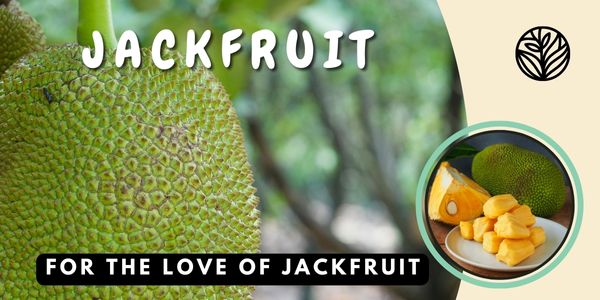What is a Jackfruit
(Artocarpus heterophyllus)
Jackfruits are the largest fruit in the world, with the current Guinness World Record reported at a colossal 42.72 kg (94 lb 2.9 oz) harvested in Pune, Maharashtra, India in 2016.
However, pictured below is the gargantuan jackfruit of 2020 found in Wayanad, Kerala, India… weighing in at an astounding 52.35 kg! That’s almost as big as me!!
Though always big, on average jackfruits usually only weigh in at a whopping 15.8kg (35 pounds), which is still ALOT of fruit right!
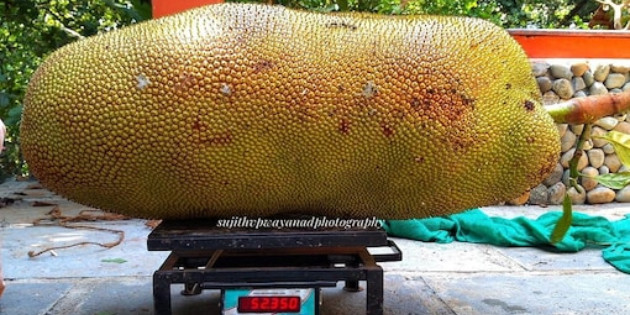
Life Cycle of a Jackfruit in Summary
So what is a Jackfruit? Well it is the fruit of the Jack Tree…
First appearing in the rainforests of India, the Jack Tree can now be found growing around the world including Thailand, Australia, Africa, Brazil and even North America. My Dad’s even attempting to grow one in Cornwall, England.
Usually found in tropical climates, they like warmth and lots of water although they have a deep taproot so can survive well during dry months, and they even grow well in sandy soil.
Growing up to 70 feet tall, Jack Trees live for over 100 years, maturing and beginning to bear fruit after about 7-10 years. Out of fruiting season, you can identify them by their large 20cm long, wide oval, glossy dark green leaves.
They have both male and female flowers on the same tree, their flowers are light green to yellow with a waxy texture. Once pollinated, the baby jackfruit grows right out of the center of the flower, getting bigger and bigger and bigger!!
And then, just before the rainy season begins… they are ready to start eating.
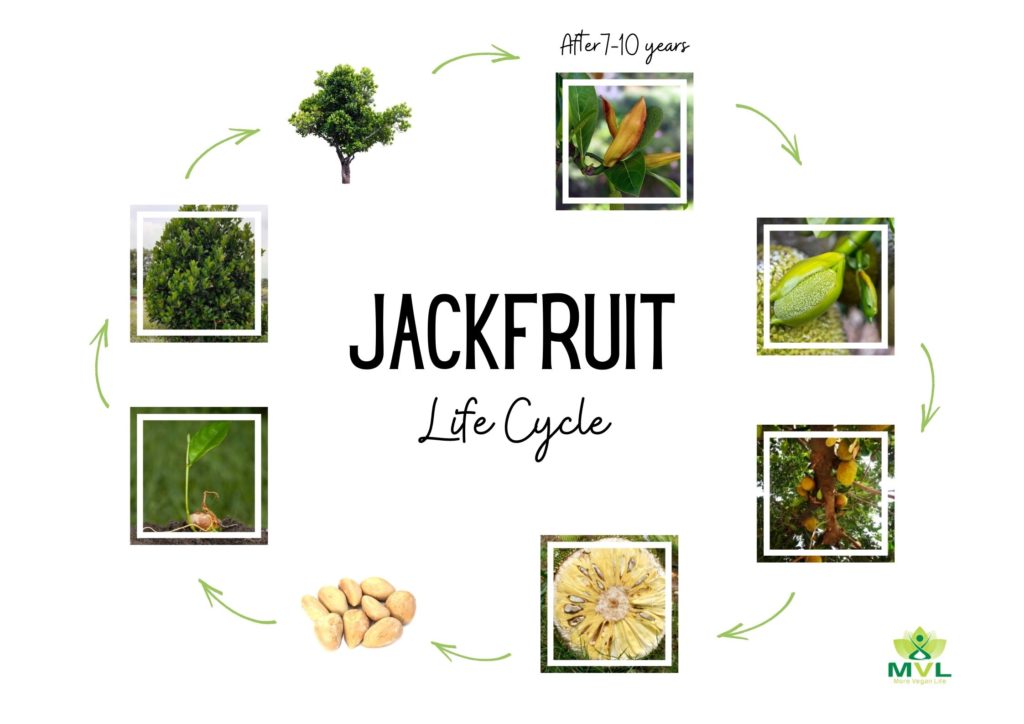
Harvesting Jackfruits from VERY Tall Trees!
We are very blessed to have a HUGE Jackfruit Tree in our Garden which produces lots of fruit each year.
Each fruit is attached to the tree by a sturdy thick stork… with super sticky, super glue like sap… so the fruits can be difficult to harvest.
The fruits only drop to the ground naturally in either VERY strong winds or when they become SUPER ripe. So ripe in fact, that they have often started fermenting while they are still on the tree and the seeds started sprouting inside the fruit.
Getting the Jackfruits off the tree either requires a very nimble climber with a sturdy knife… or, our landlords solution: some VERY long poles with hooks on the end.
Pictured below is John and our landlord, Joaquim harvesting jackfruits from our tree last season. The poles are over 4x the length of John and quite difficult to control.
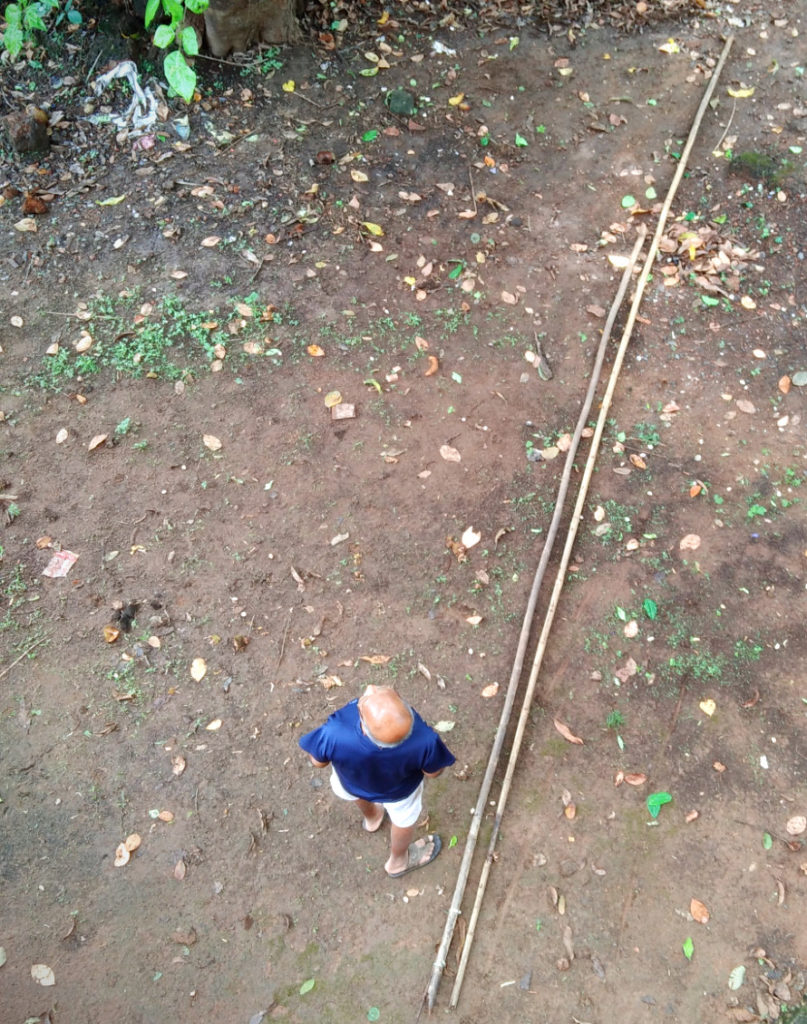
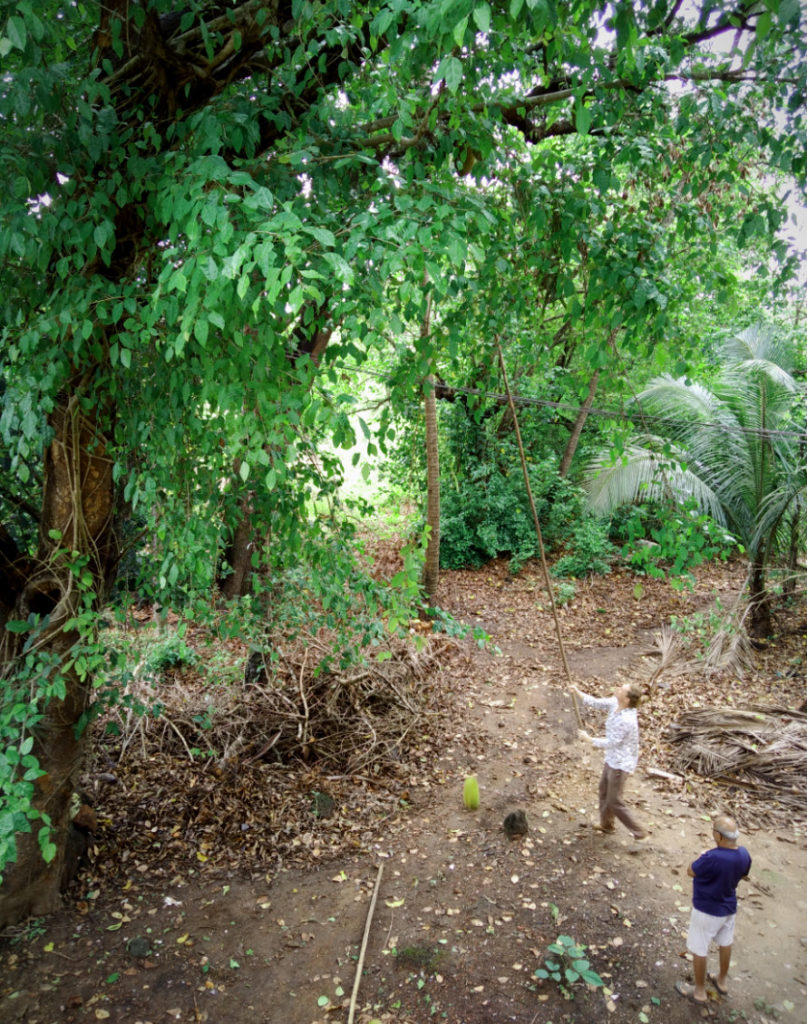
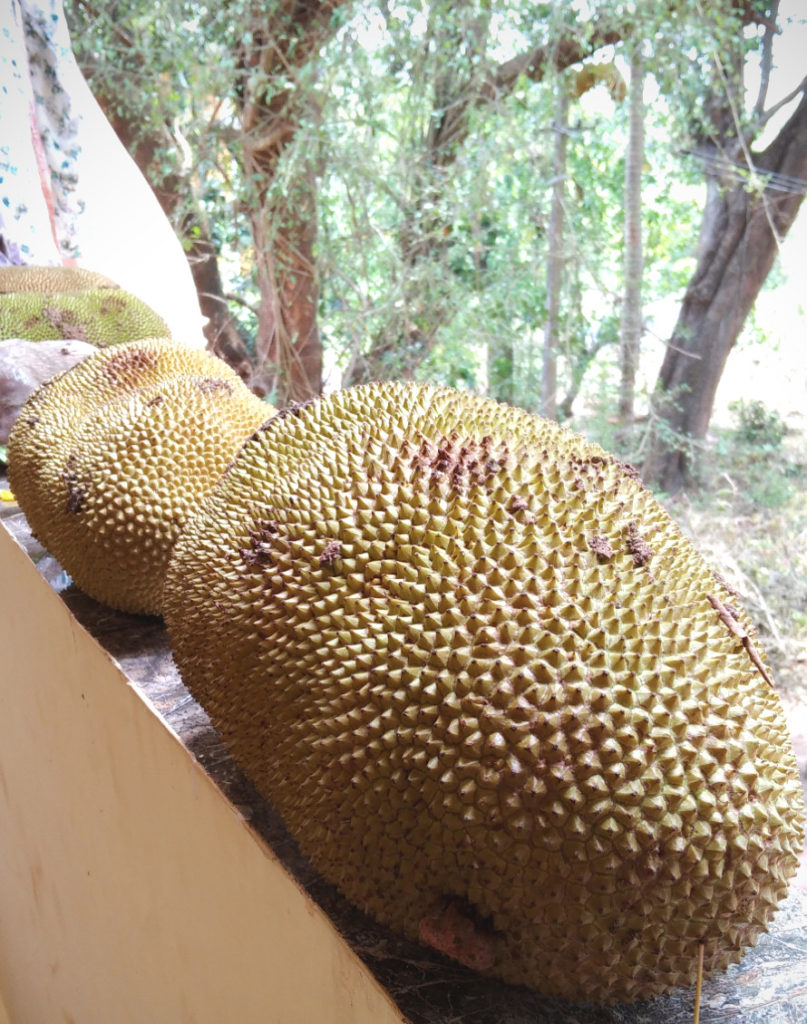
The Jackfruit FRUIT
The rind of these ginormous jackfruits are green becoming more yellow as they ripen. And the riper the fruit becomes the more pungent the smell and the sweeter the seed pods.
The skin is divided into lots of little hexagonal like segments with a blunt spikey texture. Each fruit can contain up 500 seeds each!
What is a Jackfruit: Parts of a Jackfruit
What is a Jackfruit made of… well, beneath the thick spiky green skin is:
- The Flesh: a spongy ‘meaty’ layer that turns into…
- The Rags: stringy flesh that extends down between the…
- Seed Pods: also called the Arils, yellow crunchy casings around the…
- Seeds: Big bulbous nutritious seeds
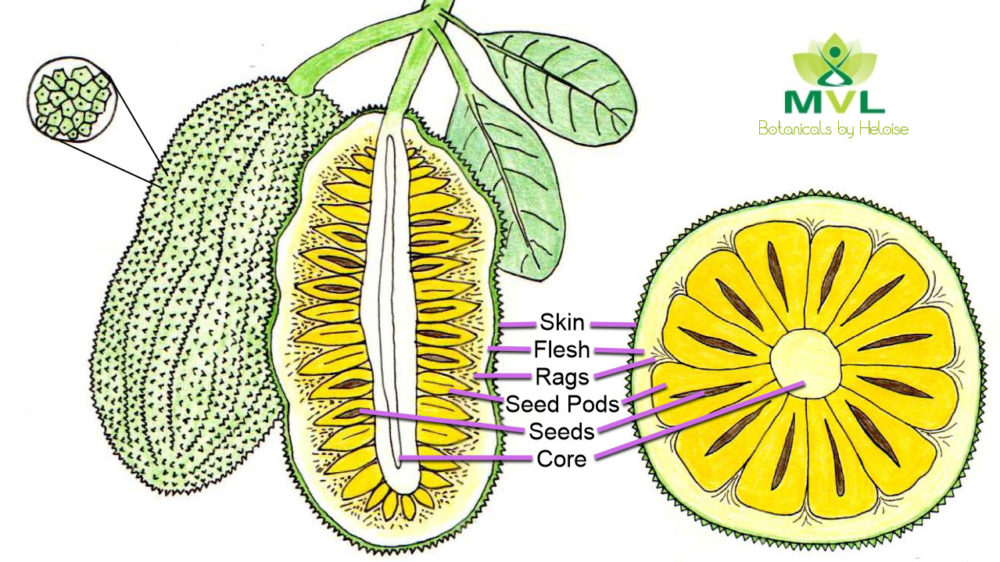 Almost ALL the parts of the tree, including the jackfruits themselves, secrete a white SUPER sticky latex-like sap when damaged. This Super Sticky Glue makes fruit preparation a little bit messy (ok, it makes it a LOT messy)!!
Almost ALL the parts of the tree, including the jackfruits themselves, secrete a white SUPER sticky latex-like sap when damaged. This Super Sticky Glue makes fruit preparation a little bit messy (ok, it makes it a LOT messy)!!
Known as a ‘Miracle Fruit’ due to its extensive health benefits and INCREDIBLE versatility, the Jackfruit can be eaten either Savoury (green unripe jackfruit) or Sweet (yellow ripe jackfruit). Traditional Medicines recommend the sticky latex sap to treat swellings, insect bites, chicken pox, etc… it can also be used to repair earthen ware. The sap of young shoots and/or sawdust from the cut jackfruit tree is used to dye monks robes yellow.
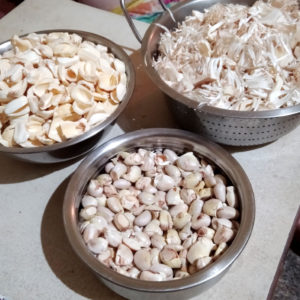
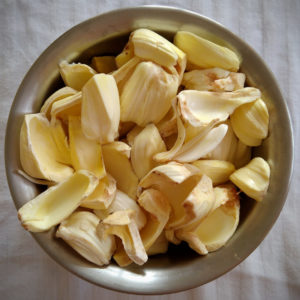
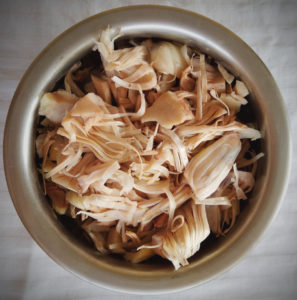
Savoury Unripe Green Jackfruit
When it is UNRIPE or GREEN (also called young or raw), everything but the skin can be eaten: when cooked the seeds taste like potatoes, the seed pods taste like whole wheat pasta, the stringy flesh around the seed pods makes an excellent vegan meat replacement, as does the spongy flesh underneath the skin.
It is these stringy and spongy fleshy parts of the fruit that have gained increasing popularity among vegans worldwide due to their meat like texture. They don’t really have a strong flavour so they take on the flavour of whatever you put them with.
Most traditional recipes out here in Goa only use the seeds and seed pods of the green jackfruit, discarding the fleshy parts! The seed pods and seeds are the most nutritious parts of the fruit but the flesh and rags are very nutritious too, and especially good as a ‘meat’ substitute.
These days most supermarkets stock tins of this Jackfruit Flesh, so even if you don’t have a ready supply from giant Jack Trees near you, you can still make my Jackfruit Sausages or John’s Jackfruit Biryani.
Savoury Green Jackfruit Dishes:
- Sauteed Pepper Jackfruit-Potatos (Seeds)
- Mediterranean Jackfruit-Pasta (Seed Pods)
- Goan Jackfruit Curry (Seeds & Seed Pods)
- Jamaican Sunrise (Seed Pods)
- Jackfruit Sausages (Rags – stringy flesh)
- Jackfruit Pasties (Stringy and spongy flesh)
- Jackfruit Dry Fry
- Jackfruit Biryani
Sweet Yellow Ripe Jackfruit
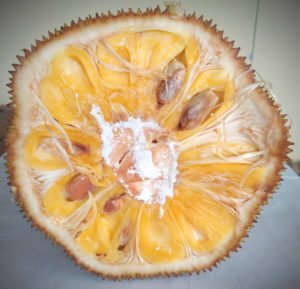 As the Jackfruit ripens the skin starts turning yellow, and the skin starts to give off a sweet smell a bit like fermenting pineapples, although sometimes described as fermenting sweaty socks!
As the Jackfruit ripens the skin starts turning yellow, and the skin starts to give off a sweet smell a bit like fermenting pineapples, although sometimes described as fermenting sweaty socks!
The jackfruit and the durian are often confused but they are two very different fruits. Although the ripe Jackfruit has a strong pungent smell… it is a sweet smell… the smell of the ripe durian has been compared to smelly socks, onions, and rotten eggs.
When the jackfruit is yellow, slightly soft and sweet smelling it is considered RIPE or YELLOW. This can ripen on the tree or it can be harvested green and will ripen quicker.
As it ripens, the seed pods get sweeter and sweeter (and the skin gets more yellow, soft and smelly)… the seed pods ripen from a crunchy texture with citrus pineapple-ish flavour… to a gooey super sweet pineapple, banana-ish flavour.
Crunchy Sweet Jackfruit pods make a delicious snack and are perfect for fruit salads… Gooey, gooey super ripe Jackfruit seed pods make AMAZING Jackfruit NiceCream.
Sweet jackfruit has quite a strong flavour, one that I LOVE but John hates! It’s definitely a love it or hate it experience!
Sweet Ripe Jackfruit Dishes:
- Sweet/Savoury Goan Jackfruit & Coconut Curry
- Jackfruit NiceCream
- Just Eat them straight out of the fruit!
Preparing Jackfruit
So this is a very sticky messy affair… and can be quite a daunting task! Which is probably why, sadly, so many jackfruits go to waste and rot on the tree. But it is definitely worth the effort and there are a few techniques to make the process a little easier.
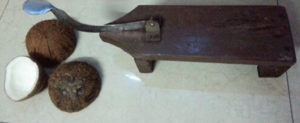 The best way to prepare it is to have a good friend help you, who is experienced in jackfruit preparation and has the traditional tools.
The best way to prepare it is to have a good friend help you, who is experienced in jackfruit preparation and has the traditional tools.
My friend has a stool with swiveling blade attached! She sits on the stool and cuts the jackfruit into small manageable wedges, then removes the skin from each of these. The stools with serrated blades are used with coconuts too…
If you have a Young Green Jackfruit, they are smaller and tend to have less sticky sap in them… they’re easier to prepare if you just want a small amount… the bigger ones taste better.
Preparing Green Unripe Jackfruit
If you use cooking oil on your hands and knife before you begin and top up throughout this massively reduces the sticky mess that otherwise ensues. Be careful though as it can make things slippy too!
Use a smooth worktop and bear in mind that any chopping boards will get covered in sap, however we always manage to get all our things clean again with a little perseverance.
How I Prepare Green/Unripe Jackfruit: At home with a knife…
- Wash your jackfruit thoroughly, removing any soil etc and set aside to dry.
- Prepare your area, use parchment paper on wood worktops, use cooking oil on your knife and hands…
- Cut the jackfruit in half horizontally
- Stand each half up on their cut edge
- Carefully cut away the green spiky skin, keeping the spongy white flesh underneath
- Then cut the top/bottom off each half, along with the stalk
- Remove skin waste, and top up on oil for knife and hands
- Cut each jackfruit half in half again vertically, cutting through the core
- At this point I would usually carefully cut out the core
- You could cut the jackfruit quarters in half again (or at least cut down to the core) before you cut out the core if this is easier.
- The idea is to slice it into manageable wedges, removing from around core.
- It depends on the size of your jackfruit as to the approach you take but you get the idea: Cut in half, remove skin, cut in half again and remove core…
- NOW, start separating the parts of your jackfruit into:
- Seed Pods (yellow Arils)
- Seeds
- String flesh (Rags)
- Spongy flesh
- Remove seed pods with seeds inside
- Separate seeds from pods. The seeds can be just popped out in riper fruit, less ripe fruit you may need to cut the seed pods open first.
- The seeds have a casing that doesn’t have a good texture or taste… sometimes it comes out with the seed sometimes it’s still inside the pod. Remove these and discard.
- You can keep the stringy and spongy flesh together but I like to separate them for using in different dishes, cutting the spongy flesh parts into inch sized chunks.
- Typically, I would then lightly boil the jackfruit pieces for 5-10 minutes in a big pan of boiling water and set aside to cool before storing them. This reduces the stickiness when I’m cooking with it.
- The jackfruit will keep in the fridge for a few weeks, or you can freeze for longer storage.
Preparing Yellow Ripe Jackfruit
The whole jackfruit is also much softer and easier to cut when it is ripe… it still has the sticky sap however you should be able to just cut the fruit open and pop the now bright yellow seed pods out.
Once the jackfruit is ripe, the spongy flesh and stringy rags are not very palatable anymore so these can be discarded.
How I Prepare Sweet Jackfruit: A lot easier the riper it is
- Wash your jackfruit thoroughly, removing any soil etc and set aside to dry.
- Prepare your area, use parchment paper on wood worktops, use cooking oil on your knife and hands…
- Cut in half vertically from the stalk all the way down. You don’t need to cut through the core, just cut down to it and all the way round back up to the stalk again
- Then you can gently prise the fruit open and the core should come away from one side… you may need to help it along with your knife in less ripe fruit.
- Remove the core.
- The jackfruit at this stage in its life is VERY gooey… with clean hands gently remove the now exposed bright yellow Arils (seed pods)
- You may need to prise the jackfruit flesh apart a bit to find all the Arils
- Separate the seeds from the seed pods (they should just pop out with a little squeeze), making sure you remove the seed casing (and discard)
- The Yellow Arils can be eaten right away (in fact I probably eat a quarter as I prepare the fruit).
- The seeds can be boiled for 20-30 minutes and then eaten
- The flesh at this stage of the fruits life isn’t good for eating, so it can be thrown away along with the skin
Nutrition & Health Benefits
Jackfruits are very nutritious, stacked full of vitamins and minerals, particularly high in Vitamin C, Potassium, Magnesium, Manganese and they are one of the rare fruits rich in B vitamins, containing ample amounts of vitamin B6 (pyridoxine), B3 (niacin), B2 (riboflavin), and B9 (folic acid).
Nutritional Values of Jackfruit
(Source: USDA National Nutrient data base)
100g Jackfruit Contains:
| Energy :: 95 Kcal :: 5% of RDA |
| Carbohydrates :: 23.5 g :: 18% of RDA |
| Protein :: 1.72 g :: 3% of RDA |
| Total Fat :: 0.64 g :: 3% of RDA |
| Cholesterol :: 0 mg :: 0% of RDA |
| Dietary Fiber :: 1.5 g :: 4% of RDA |
| Folates :: 24 µg :: 6% of RDA |
| Niacin :: 0.920 mg :: 6% of RDA |
| Pyridoxine :: 0.329 mg :: 25% of RDA |
| Riboflavin :: 0.055 mg :: 4% of RDA |
| Thiamin :: 0.105 mg :: 9% of RDA |
| Vitamin A :: 110 IU :: 3.5% of RDA |
| Vitamin C :: 13.7 mg :: 23% of RDA |
| Vitamin E :: 0.34 mg :: 2% of RDA |
| Sodium :: 3 mg :: 0% of RDA |
| Potassium :: 303 mg :: 6.5% of RDA |
| Calcium :: 34 mg :: 3.4% of |
| Iron :: 0.60 mg :: 7.5% of RDA |
| Magnesium :: 37 mg :: 9% of RDA |
| Manganese :: 0.197 mg :: 8.5% of RDA |
| Phosphorus :: 36 mg :: 5% of RDA |
| Phosphorus :: 21 mg :: 3% of RDA |
| Selenium :: 0.6 mg :: 1% of RDA |
| Zinc :: 0.42 mg :: 4% of RDA |
| Carotene-ß :: 61 µg |
| Crypto-xanthin-ß :: 5 µg |
| Lutein-zeaxanthin :: 157 µg |
Stacked full of Vitamins & Minerals
Vitamin C: The high Vitamin C content also helps your body develop resistance to infectious agents and harmful free radicals. It rejuvenates white blood cells helping you to fight off infections, bacteria and viruses, as well as generally boosting your immune system.
This amazing vitamin: Keeps skin healthy • Rejuvenates white blood cells • Increases fertility in Men • Boosts immune system functioning • Improves iron absorption from food • Keeps arteries clear • Increases good HDL cholesterol • Lowers bad LDL cholesterol • Boosts antioxidant activity • Protects against gum disease • Protects against cataracts • Reduces lung and breathing problems such as asthma • Helps fight against the development of cancers • Reduces high blood pressure
Magnesium: Keeps bones and teeth young and strong • Lowers high blood pressure • Maintains blood sugar levels • Keeps arteries clear • Improves recovery from heart attacks • Helps protect against heart disease • Helps protect against skeletal defects • Helps protect against diabetes
Vitamin B6 (Pyridoxine): Keeps skin healthy • Boosts Serotonin, happy chemicals in our brain • Helps protect against Heart Disease • Keeps Immune Systems healthy • Boosts nerve cell communication
Vitamin B9 (Folate): Vital in cell growth and repair • Helps protect against heart disease • Helps reduce risk of strokes • Improves memory and mental agility • Boosts Serotonin in our brain, keeping us happy
Vitamin A: Maintains healthy skin • Strengthens the immune system • Increases T-cells (Tlymphocytes) efficiency • Maintains healthy bone growth and cell development • Increases night vision and eye health
Beta Carotene: Boosts immune system functioning • Keeps arteries clear • Helps prevent strokes • Helps prevent heart attacks • Helps prevent the development of cancers
Antioxidant: Our bodies need oxygen to function properly, the side effect of essential oxygen reactions in our bodies is the release of free radicals, a form of oxygen. They are unstable molecules that try to complete themselves by stealing from cells.
Antioxidants are the bodies defense against free radicals. Formed out of enzymes, nutrients and other chemical compounds, antioxidants stop the formation of free radicals by giving the unstable molecule what it needs to complete itself and repair the damage caused.
The riper the fruit, the higher the antioxidant levels.
Powerful Super Seeds:
While the whole jackfruit is high in all these nutritional benefits the seeds are the biggest powerhouse of nutrition and protein… they also taste GREAT, like small potatoes with a nutty undertone.
Jackfruit seeds also contain a protein called jacalin, a lectin that binds with certain carbohydrates and has been found to protect immune system cells from HIV infection.
RISKS: Allergies are rare… Birch Pollen Allergy sufferers may experience itchy mouth or swollen lips like when they eat apples, carrots, celery, cherries, nuts, etc.
Try Orangic Young Jackfruit
For those of you in the UK with no access to these AMAZING Jack Trees, we have organic jackfruit chunks in brine water ready to be delivered direct to your door.
Making Jackfruit Sausages – Recipe 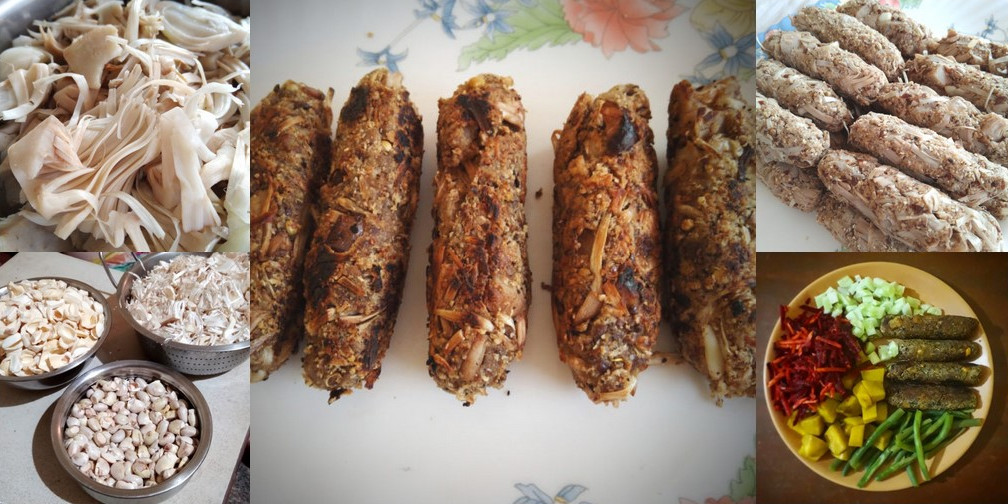
This Jackfruit Sausage Recipe is perfect for store bought Jackfruit Chunks. They are super easy to make and super yummy.
